The Neuromarketing Concept in Artificial Neural Networks: A Case of Forecasting and Simulation from the Advertising Industry
Abstract
:1. Introduction
1.1. Neuromarketing
1.2. Definition of Neuromarketing
1.3. The Birth of the Neuromarketing Concept
1.4. Importance of Neuromarketing
1.5. Background, Justification, and Purpose of the Study
2. Review of Literature
2.1. Neuromarketing and Human Decision-Making
2.2. Neuromarketing Main Tools
2.2.1. Positron Emission Tomography (PET)
2.2.2. Functional Magnetic Resonance Imaging (fMRI)
2.2.3. Electroencephalography (EEG)
2.2.4. Steady-State Probe Topography (SSPT)
2.2.5. Eye-Tracking
2.2.6. Magnetoencephalography (MEG)
2.2.7. Transcranial Magnetic Stimulation (TMS)
2.2.8. Facial Action Coding System (FACS)
2.2.9. Galvanic Skin Response (GSR)
2.2.10. Implicit Association Test (IAT)
2.3. Examples of Neuromarketing Applications
2.4. Artificial Neural Networks
2.4.1. Definition of Artificial Neural Networks
2.4.2. General Characteristics of Artificial Neural Networks
- Artificial neural networks perform machine learning.
- There is an information processing method utterly different from the methods in which traditional programming and artificial intelligence are applied [61].
- Fault-tolerant; the ability to work with incomplete information allows them to tolerate errors. If some network cells become corrupted and fail to work, the network will continue to run. Traditional computers usually require complete data [62].
- Can work with incomplete information; after being trained, artificial neural networks can produce results even with incomplete information in the new samples, while traditional systems cannot work with incomplete information [63].
- The artificial neural networks can organize and learn themselves, and artificial neural networks can adapt to novel situations to learn innovative events regularly [64].
- It has distributed memory; information in artificial neural networks is spread over the network. That is, the whole network characterizes the whole event [65].
- It can only work with numerical information; the information indicated by symbolic expressions must be translated into numerical values [66].
- It can detect events, shape and classify relationships, and pattern completion.
2.4.3. Advantages of Artificial Neural Networks
3. Methods
3.1. Fundamental Elements and Structure of the Artificial Neural Network
- Input Layer: There must be at least one predictor or element from the raw data set in the input layer. The input layer generates similar values without processing any estimation [70].
- Intermediate/Hidden Layer: This section or layer, also known as the hidden layer, is responsible for estimating and processing the raw data. The hidden or process layer has a specific function and structure, which could have variations as per the selected structure of networks. The middle or hidden layer could be comprised of one or more layers [78].
- Output Layer: The output may comprise at least one or more outputs. However, it solely depends on the neural network’s structure and function. The estimation operation is processed in this layer, and the estimated output will be directed to the outside world [69].
3.2. Research Structure and Aim of the Project
3.3. Input Criteria
3.4. Output Criteria
- Consumer buying behavior: It is a metric indicative of the measured image that can gather respondents’ concentration on their own. However, consumer buying behavior is the core function of the human brain, which generates unique brainwave activity patterns towards the change of behavior for buying some brands due to the stimuli of brains because of some essential characteristics of an advertisement of any brand [85].
- Predicted buying behavior: It is a neural network-generated predictive indicator that measures images that can influence respondents’ consumer buying behavior. It is a predictive function of the human brain, which generates unique brainwave activity patterns towards the change of behavior for buying the particular brand due to the stimuli of brains because of some essential characteristics of an advertisement of any brand [70].
3.5. Application
3.6. Creation of Artificial Neural Network Models
4. Results and Findings
4.1. First Application Using Model Training and Testing
4.2. Case Processing Summary of the First Application
4.3. Model Summary of the First Application
4.4. Model of the First Application
4.5. Parameter Estimates
4.6. Predictors’ Importance
4.7. Normalized Importance
4.8. Second Application Using Model Taring and Testing—Model Summary
4.9. Model of the First Application
4.10. Parameter Estimates
4.11. Predictors’ Importance
4.12. Normalized Importance
4.13. Forecasting of Neuromarketing Outputs
5. Discussion
6. Conclusions
6.1. Theoretical and Practical Implications
6.2. Limitations and Potential Areas of Future Studies
Supplementary Materials
Author Contributions
Funding
Institutional Review Board Statement
Informed Consent Statement
Data Availability Statement
Conflicts of Interest
References
- Gurgu, R.; Gurgu, I.; Tonis, R. Neuromarketing for a better understanding of consumer needs and emotions. Indep. J. Manag. Prod. 2020, 11, 208–235. [Google Scholar] [CrossRef]
- Hafez, M. Neuromarketing: A new avatar in branding and advertisement. Pac. Bus. Rev. Int. 2019, 12, 58–64. [Google Scholar]
- Harris, J.; Ciorciari, J.; Gountas, J. Consumer neuroscience and digital/social media health/social cause advertisement effectiveness. Behav. Sci. 2019, 9, 42. [Google Scholar] [CrossRef] [PubMed] [Green Version]
- Vences, N.A.; Díaz-Campo, J.; Rosales, D.F.G. Neuromarketing as an Emotional Connection Tool Between Organizations and Audiences in Social Networks. A Theoretical Review. Front. Psychol. 2020, 11, 1787. [Google Scholar] [CrossRef] [PubMed]
- Lim, W.M. Demystifying neuromarketing. J. Bus. Res. 2018, 91, 205–220. [Google Scholar] [CrossRef]
- Fisher, C.E.; Chin, L.; Klitzman, R. Defining neuromarketing: Practices and professional challenges. Harv. Rev. Psychiatry 2010, 18, 230–237. [Google Scholar] [CrossRef]
- Wilson, M.R.; Gaines, J.; Hill, R.P. Neuromarketing and consumer free will. J. Consum. Aff. 2008, 42, 389–410. [Google Scholar] [CrossRef]
- Laybourne, P.; Lewi, D. Neuromarketing: The future of consumer research? Admap 2005, 461, 28–30. [Google Scholar]
- Sano, Y.; Takayasu, H.; Havlin, S.; Takayasu, M. Identifying long-term periodic cycles and memories of collective emotion in online social media. PLoS ONE 2019, 14, e0213843. [Google Scholar] [CrossRef]
- Lee, N.; Broderick, A.J.; Chamberlain, L. What is “neuromarketing”? A discussion and agenda for future research. Int. J. Psychophysiol. 2006, 63, 199–204. [Google Scholar] [CrossRef]
- Hsu, L.; Chen, Y.-J. Neuromarketing, subliminal advertising, and hotel selection: An EEG study. Australas. Mark. J. 2020, 28, 200–208. [Google Scholar] [CrossRef]
- Suomal, J.; Palokangas, L.; Leminen, S.; Westerlund, M.; Heinonen, J.; Numminen, J. Neuromarketing: Understand customers’ subconscious responses to marketing. Technol. Innov. Manag. Rev. 2012, 2, 12–21. [Google Scholar] [CrossRef]
- Ponnam, A. A case for customer based brand equity conceptualization within motivational perspective. Acad. Mark. Stud. J. 2011, 15, 61–70. [Google Scholar]
- Peterson, R.L. The neuroscience of investing: fMRI of the reward system. Brain Res Bull. 2005, 67, 391–397. [Google Scholar] [CrossRef] [PubMed]
- Ariely, D.; Berns, G.S. Neuromarketing: The hope and hype of neuroimaging in business. Nat. Rev. Neurosci. 2010, 11, 284–292. [Google Scholar] [CrossRef] [Green Version]
- Hammou, K.A.; Galib, M.H.; Melloul, J. The Contributions of Neuromarketing in Marketing Research. J. Manag. Res. 2013, 5, 20–33. [Google Scholar] [CrossRef] [Green Version]
- Murphy, E.R.; Illes, J.; Reiner, P.B. Neuroethics of neuromarketing. J Consum Behav. 2008, 7, 293–302. [Google Scholar] [CrossRef] [Green Version]
- Crespo-Pereira, V.; Legerén-Lago, B.; Arregui-McGullion, J. Implementing Neuromarketing in the Enterprise: Factors That Impact the Adoption of Neuromarketing in Major Spanish Corporations. Front. Commun. 2020, 5, 576789. [Google Scholar] [CrossRef]
- Renvoise, C.; Morin, P. Neuromarketing: Understanding the "Buy Button" in Your Customer’s Brain; Thomas Nelson Publishers: Nashville, TN, USA, 2007. [Google Scholar]
- Morin, C. Neuromarketing: The new science of consumer behavior. Society 2011, 48, 131–135. [Google Scholar] [CrossRef] [Green Version]
- Marcel, P.; Lacramioara, R.; Maniu, I.; Zaharie, M. Neuromarketing—Getting inside the customer’s mind. Ann. Univ. Oradea Econ. Sci. 2009, 4, 804–807. [Google Scholar]
- Al-Sharif, A.H.; Salleh, N.Z.M.; Baharun, R.; Yusoff, M.F. Consumer Behaviour Through Neuromarketing Approach. J. Contemp. Issues Bus. Gov. 2021, 27, 344–354. [Google Scholar] [CrossRef]
- Kurtoğlu, A.L.; Ferman, A.M. An exploratory research among fashion business leaders and neuromarketing company executives on the perception of applied neuromarketing. Pressacademia 2020, 11, 230–232. [Google Scholar] [CrossRef]
- Juarez, D.; Tur-Viñes, V.; Mengual, A. Neuromarketing Applied to Educational Toy Packaging. Front. Psychol. 2020, 11, 2077. [Google Scholar] [CrossRef] [PubMed]
- Vidal-Raméntol, S. Neuromarketing and Sustainability. Adv. Soc. Sci. Res. J. 2020, 7, 181–191. [Google Scholar] [CrossRef]
- Schreiner, M.; Fischer, T.; Riedl, R. Impact of content characteristics and emotion on behavioral engagement in social media: Literature review and research agenda. Electron. Comm. Res. 2019, 21, 329–345. [Google Scholar] [CrossRef] [Green Version]
- Sheline, Y.I. 3D MRI studies of neuroanatomic changes in unipolar major depression: The role of stress and medical comorbidity. Biol. Psychiatry 2000, 48, 791–800. [Google Scholar] [CrossRef]
- Nash, K.; Johansson, A.; Yogeeswaran, K. Social media approval reduces emotional arousal for people high in narcissism: Electrophysiological evidence. Front. Hum. Neurosci. 2019, 13, 292. [Google Scholar] [CrossRef]
- Hubert, M. Does neuroeconomics give new impetus to economic and consumer research? J. Econ. Psychol. 2010, 31, 812–817. [Google Scholar] [CrossRef]
- Libert, A.; Van Hulle, M.M. Predicting premature video skipping and viewer interest from EEG recordings. Entropy 2019, 21, 1014. [Google Scholar] [CrossRef] [Green Version]
- Madan, C.R. Neuromarketing: The next step in market research? Eureka 2010, 1, 34–42. [Google Scholar] [CrossRef]
- Muñoz-Leiva, F.; Hernández-Méndez, J.; Gómez-Carmona, D. Measuring advertising effectiveness in Travel 2.0 websites through eye-tracking technology. Physiol. Behav. 2019, 200, 83–95. [Google Scholar] [CrossRef] [PubMed]
- Mañas-Viniegra, L.; Veloso, A.I.; Cuesta, U. Fashion promotion on Instagram with eye tracking: Curvy girl influencers versus fashion brands in Spain and Portugal. Sustainability 2019, 11, 3977. [Google Scholar] [CrossRef] [Green Version]
- Tovino, S.A. The confidentiality and privacy implications of functional magnetic resonance imaging. J. Law Med. Ethics 2005, 33, 844–850. [Google Scholar] [CrossRef] [PubMed]
- Lewinski, P.; Fransen, M.L.; Tan, E.S.H. Predicting advertising effectiveness by facial expressions in response to amusing persuasive stimuli. J. Neurosci. Psychol. Econ. 2014, 7, 1–14. [Google Scholar] [CrossRef] [Green Version]
- Guixeres, J.; Bigne, E.; Azofra, J.M.A.; Raya, M.A.; Granero, A.C.; Hurtado, F.F.; Ornedo, V.N. Consumer neuroscience-based metrics predict recall, liking and viewing rates in online advertising. Front. Psychol. 2017, 8, 1808. [Google Scholar] [CrossRef]
- Gómez-Adorno, H.; Markov, I.; Sidorov, G.; Posadas-Durán, J.P.; Sánchez-Pérez, M.; Chanona-Hernández, L. Improving feature representation based on a neural network for author profiling in social media texts. Comput. Intell. Neurosci. 2016, 2016, 1638936. [Google Scholar] [CrossRef] [Green Version]
- Racine, E.; Bar-Ilan, O.; Illes, J. FMRI in the public eye. Nat. Rev. Neurosci. 2005, 6, 159–164. [Google Scholar] [CrossRef] [Green Version]
- Eser, Z.; Isin, F.B.; Tolon, M. Perceptions of marketing academics, neurologists, and marketing professionals about neuromarketing. J. Mark. Manag. 2011, 27, 854–868. [Google Scholar] [CrossRef]
- Bault, N.; Rusconi, E. The art of influencing consumer choices: A reflection on recent advances in decision neuroscience. Front. Psychol. 2020, 10, 3009. [Google Scholar] [CrossRef] [Green Version]
- Shukla, A.K.; Kumar, U. Positron emission tomography: An overview. J. Med. Phys. 2006, 31, 13–21. [Google Scholar] [CrossRef]
- Fugate, D.L. Marketing services more effectively with neuromarketing research: A look into the future. J. Serv. Mark. 2008, 22, 170–173. [Google Scholar] [CrossRef]
- Kulich, R.; Maciewicz, R.; Scrivani, S.J. Functional magnetic resonance imaging (fMRI) and expert testimony. Am. Acad. Pain Med. 2009, 10, 373–380. [Google Scholar] [CrossRef] [PubMed] [Green Version]
- Mencarelli, L.; Neri, F.; Momi, D.; Menardi, A.; Ross, S.; Rossi, A.; Santarnecchi, E. Stimuli, presentation modality, and load-specific brain activity patterns during n-back task. Hum. Brain Mapp. 2019, 40, 3810–3831. [Google Scholar] [CrossRef] [Green Version]
- Breiter, H.C.; Aharon, I.; Kahneman, D.; Dale, A.; Shizgal, P. Functional imaging of neural responses to expectancy and experience of monetary gains and losses. Neuron 2001, 30, 619–639. [Google Scholar] [CrossRef] [Green Version]
- Reimann, M.; Schilke, O.; Weber, B.; Neuhaus, C.; Zaichkowsky, J. Functional magnetic resonance imaging in consumer research: A review and application. Psychol. Mark. 2011, 28, 608–637. [Google Scholar] [CrossRef]
- Ohme, R.; Reykowska, D.; Wiener, D.; Choromanska, A. Analysis of neurophysiological reactions to advertising stimuli by means of EEG and galvanic skin response measures. J. Neurosci. Psychol. Econ. 2009, 2, 21–31. [Google Scholar] [CrossRef] [Green Version]
- Fugate, D.L. Neuromarketing: A layman’s look at neuroscience and its potential application to marketing practice. J. Consum. Mark. 2007, 24, 385–394. [Google Scholar] [CrossRef]
- Samuel, B.S.; Prasanth, V.T. Neuromarketing: Is Campbell in soup? IUP J. Mark. Manag. 2012, 11, 76–100. [Google Scholar]
- Ambler, T.; Ioannides, A.; Rose, S. Brand on the brain: Neuro-images of advertising. Bus. Strategy Rev. 2000, 11, 17–30. [Google Scholar] [CrossRef]
- McClure, S.-M.; Li, J.; Tomlin, D.; Cypert, K.; Montague, L.; Montague, P. Neural Correlates of Behavioral Preference for Culturally Familiar Drinks. Neuron 2004, 44, 379–387. [Google Scholar] [CrossRef] [Green Version]
- Al-Abaid, S.A. Artificial Neural Network Based Image Encryption Technique. J. Adv. Res. Dyn. Control. Syst. 2020, 12, 1184–1189. [Google Scholar] [CrossRef]
- Chen, H.; Lu, F.; He, B. Topographic property of backpropagation artificial neural network: From human functional connectivity network to artificial neural network. Neurocomputing 2020, 418, 200–210. [Google Scholar] [CrossRef]
- Lv, X.; Yang, Y.; Qin, D.; Cao, X.; Xu, H. Artificial intelligence service recovery: The role of empathic response in hospitality customers’ continuous usage intention. Comput. Hum. Behav. 2022, 126, 106993. [Google Scholar] [CrossRef]
- Vijayan, V.; Rubasundram, G.A. Artificial Neural Network (ANN): An Artificial Intelligent (AI) Tool to Predict Fraudulent Financial Reporting and Financial Distress. Int. J. Psychosoc. Rehabil. 2020, 24, 1215–1226. [Google Scholar] [CrossRef]
- Maillefer, V.A.; Udayar, S.; Fiori, M. Enhancing the Prediction of Emotionally Intelligent Behavior: The PAT Integrated Framework Involving Trait EI, Ability EI, and Emotion Information Processing. Front. Psychol. 2018, 9, 1078. [Google Scholar] [CrossRef] [Green Version]
- Banjade, D. Forecasting Bitcoin Price using Artificial Neural Network. SSRN Electron. J. 2020, 1–13. [Google Scholar] [CrossRef]
- Chan, V.K.H.; Chan, C.W. Towards explicit representation of an artificial neural network model: Comparison of two artificial neural network rule extraction approaches. Petroleum 2020, 6, 329–339. [Google Scholar] [CrossRef]
- Macukow, B. Neural Networks—State of Art, Brief History, Basic Models and Architecture. In Computer Information Systems and Industrial Management; CISIM 2016. Lecture Notes in Computer Science (LNCS), 9842; Saeed, K., Homenda, W., Eds.; Springer: Cham, Switzerland, 2016. [Google Scholar] [CrossRef] [Green Version]
- Alblushi, A. Face Recognition Based on Artificial Neural Network: A Review. Artif. Intell. Robot. Dev. J. 2021, 1, 116–131. [Google Scholar] [CrossRef]
- Li, L.; Zhang, Z.; Lu, J. Artificial fly visual joint perception neural network inspired by multiple-regional collision detection. Neural Netw. 2021, 135, 13–28. [Google Scholar] [CrossRef]
- Barai, D.P.; Bhanvase, B.A.; Pandharipande, S.L. Artificial neural network for prediction of thermal conductivity of rGO–metal oxide nanocomposite-based nanofluids. Neural Comput. Appl. 2021, 34, 271–282. [Google Scholar] [CrossRef]
- Shahiri, A.M.; Husain, W.; Rashid, A.N. A review on predicting student’s performance using data mining techniques. Procedia Comput. Sci. 2015, 72, 414–422. [Google Scholar] [CrossRef] [Green Version]
- Macfadyen, L.P.; Dawson, S. Mining LMS data to develop an “early warning system” for educators: A proof of concept. Comput. Educ. 2010, 54, 588–599. [Google Scholar] [CrossRef]
- Lykourentzou, I.; Giannoukos, I.; Mpardis, G.; Nikolopoulos, V.; Loumos, V. Early and dynamic student achievement prediction in e-learning courses using neural networks. J. Am. Soc. Inf. Sci. 2009, 60, 372–380. [Google Scholar] [CrossRef]
- Kanakana, G.M.; Olanrewaju, A.O. Predicting student performance in engineering education using an artificial neural network at Tshwane university of technology. In Proceedings of the International Conference on Industrial Engineering, Systems Engineering and Engineering Management for Sustainable Global Development, Stellenbosch, South Africa, 21–23 September 2011; pp. 1–7. [Google Scholar]
- Shaikh, R.; Shirazian, S.; Walker, G.M. Application of artificial neural network for prediction of particle size in pharmaceutical cocrystallization using mechanochemical synthesis. Neural. Comput. Appl. 2021, 33, 12621–12640. [Google Scholar] [CrossRef]
- Tonbul, T. Sales Forecast in FMCG Sector with Artificial Neural Networks. Project; Istanbul Technical University: Istanbul, Turkey, 2019. [Google Scholar] [CrossRef]
- Aka, H.; Aktuğ, Z.B.; Kılıç, F. Estimating the England Premier League Ranking with Artificial Neural Network. Appl. Artif. Intell. 2021, 35, 393–402. [Google Scholar] [CrossRef]
- Panda, S.; Panda, G. Performance Evaluation of a New BP Algorithm for a Modified Artificial Neural Network. Neural Process. Lett. 2020, 51, 1869–1889. [Google Scholar] [CrossRef]
- Duong, H.T.; Phan, H.C.; Tran, T.M.; Dhar, A.S. Assessment of critical buckling load of functionally graded plates using artificial neural network modeling. Neural Comput. Appl. 2021, 33, 16425–16437. [Google Scholar] [CrossRef]
- Jayne, C.; Lanitis, A.; Christodoulou, C. Neural network methods for one-to-many multi-valued mapping problems. Neural Comput. Appl. 2011, 20, 775–785. [Google Scholar] [CrossRef]
- Das, S. A Comparative Study of Legendre Neural Network and Chebyshev Functional Link Artificial Neural Network for Diabetes Data Classification. Int. J. Eng. Res. 2020, V9. [Google Scholar] [CrossRef]
- Pang, Z.; Niu, F.; O’Neill, Z. Solar radiation prediction using recurrent neural network and artificial neural network: A case study with comparisons. Renew. Energy 2020, 156, 279–289. [Google Scholar] [CrossRef]
- Mohammed, S.; Ramos, C.; Fang, W.C.; Kim, T.-H. Emerging higher-level artificial neural network-based intelligent systems. Neural Comput. Appl. 2021, 33, 4595–4597. [Google Scholar] [CrossRef]
- Song, J.; Zhang, Y.; Cheng, J.; Wang, S.; Liu, Z.; Sun, D. Non-invasive quantitative diagnosis of liver fibrosis with an artificial neural network. Neural Comput. Appl. 2021, 34, 6733–6744. [Google Scholar] [CrossRef]
- Awad, M.; Khanna, R. Deep Neural Networks. In Efficient Learning Machines; Apress: Berkeley, CA, USA, 2015. [Google Scholar] [CrossRef] [Green Version]
- Li, K.; Ramkumar, S.; Thimmiaraja, J.; Diwakaran, S. Optimized artificial neural network based performance analysis of wheelchair movement for ALS patients. Artif. Intell. Med. 2020, 102, 101754. [Google Scholar] [CrossRef] [PubMed]
- Wu, D.; Wang, G.G. Causal artificial neural network and its applications in engineering design. Eng. Appl. Artif. Intell. 2021, 97, 104089. [Google Scholar] [CrossRef]
- Fuengfusin, N.; Tamukoh, H. Network with Sub-networks: Layer-wise Detachable Neural Network. J. Robot. Netw. Artif. Life 2020, 7, 240. [Google Scholar] [CrossRef]
- Teles, G.; Rodrigues, J.J.P.C.; Rabê, R.A.L.; Kozlov, S.A. Artificial neural network and Bayesian network models for credit risk prediction. J. Artif. Intell. Syst. 2020, 2, 118–132. [Google Scholar] [CrossRef]
- Lawal, A.I.; Kwon, S.; Kim, G.Y. Prediction of an environmental impact of tunnel blasting using ordinary artificial neural network, particle swarm and Dragonfly optimized artificial neural networks. Appl. Acoust. 2021, 181, 108122. [Google Scholar] [CrossRef]
- Sharma, A.; Soni, S.; Rai, K. Link Prediction in Social Network using Artificial Neural Network. Int. J. Comput. Appl. 2021, 174, 26–30. [Google Scholar] [CrossRef]
- Allahyari, E. Application of artificial neural network in predicting EI. BioMedicine 2020, 10, 18–24. [Google Scholar] [CrossRef]
- Mitra, S.; Nigam, R. Artificial Neural Network Methods for Prediction of River Flow. Adalya J. 2020, 9. [Google Scholar] [CrossRef]
- Paliwal, M.; Kumar, U.A. A study of academic performance of business school graduates using neural network and statistical techniques. Expert Syst. Appl. 2009, 36, 7865–7872. [Google Scholar] [CrossRef]
- Feng, Y.; Hao, L. Testing Randomness Using Artificial Neural Network. IEEE Access. 2020, 8, 163685–163693. [Google Scholar] [CrossRef]
- Sidorov, O.Y.; Aristova, N.A. Simulation of Coke Quality Indicators Using Artificial Neural Network. KnE Eng. 2020, 2020, 21–28. [Google Scholar] [CrossRef] [Green Version]
- Mirza, M. Detecting Depression in Elderly People by Using Artificial Neural Network. Elder. Health J. 2020, 6, 103–108. [Google Scholar] [CrossRef]
- Saima, H.; Ahmed, R.R.; Shamsi, A.F. Technology Confirmation is associated to Improved Psychological Wellbeing: Evidences from an Experimental Design. Transform. Bus. Econ. 2021, 20, 177–196. [Google Scholar]
- Parmar, V.; Channar, Z.A.; Ahmed, R.R.; Štreimikienė, D.; Pahi, M.H.; Streimikis, J. Assessing the organizational commitment, subjective vitality and burnout effects on turnover intention in private universities. Oeconomia Copernic. 2022, 13, 251–286. [Google Scholar] [CrossRef]
- Kim, S.A.; Kim, S.H.; Hamann, S. Neural and self-reported responses to antisocial news stories: Entertaining versus traditional news introduction. Comput. Hum. Behav. 2022, 126, 106994. [Google Scholar] [CrossRef]
- Štreimikienė, D.; Mikalauskienė, A.; Sturienė, U.; Kyriakopoulos, G.L. The impact of social media on sales promotion in entertainment companies. E&M Ekon. Manag. 2021, 24, 189–206. [Google Scholar] [CrossRef]
- Ahmed, R.R.; Štreimikienė, D.; Berchtold, G.; Vveinhardt, J.; Channar, Z.A.; Soomro, R.H. Effectiveness of online digital media advertising as a strategic tool for building brand sustainability: Evidence from FMCGs and Services sectors of Pakistan. Sustainability 2019, 11, 3436. [Google Scholar] [CrossRef] [Green Version]
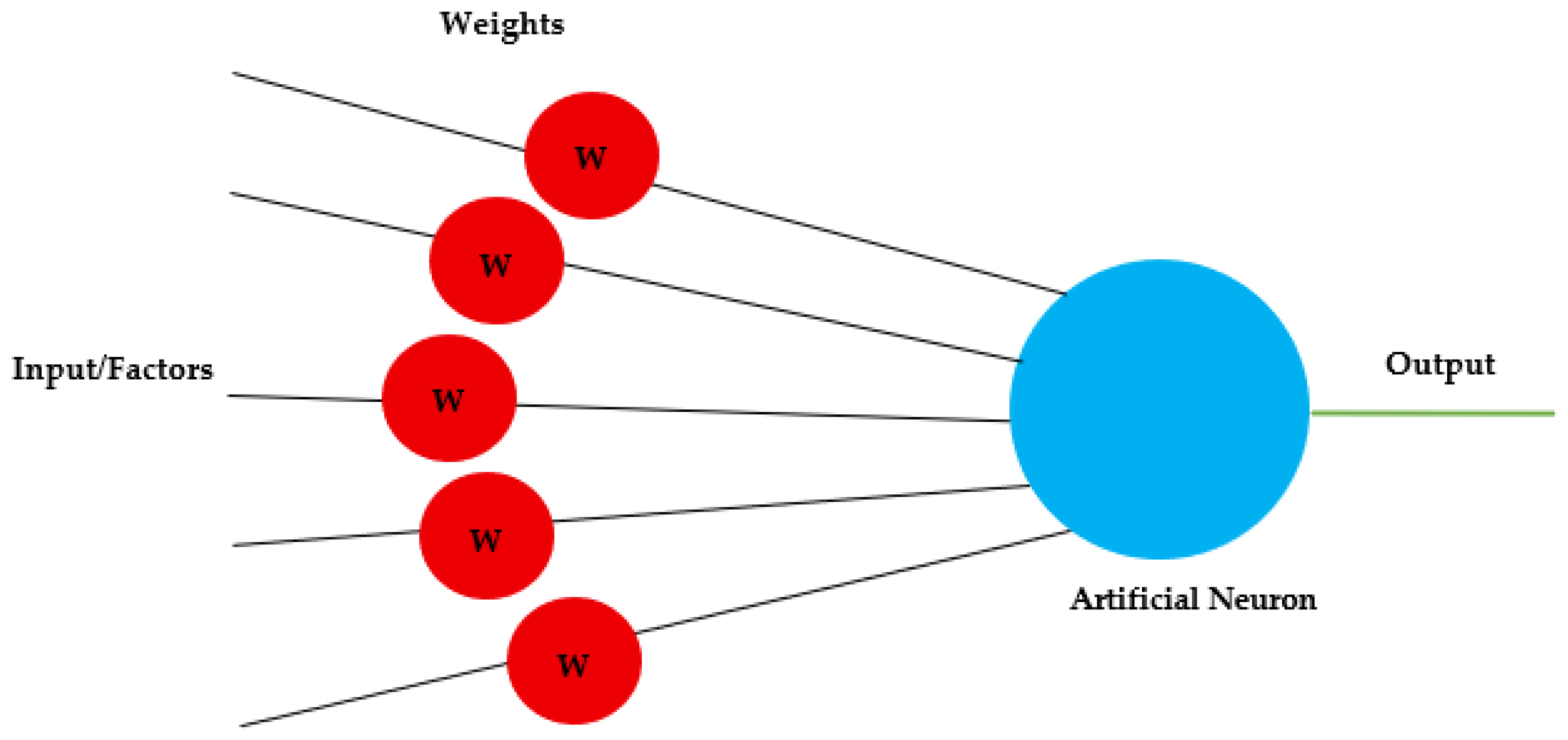
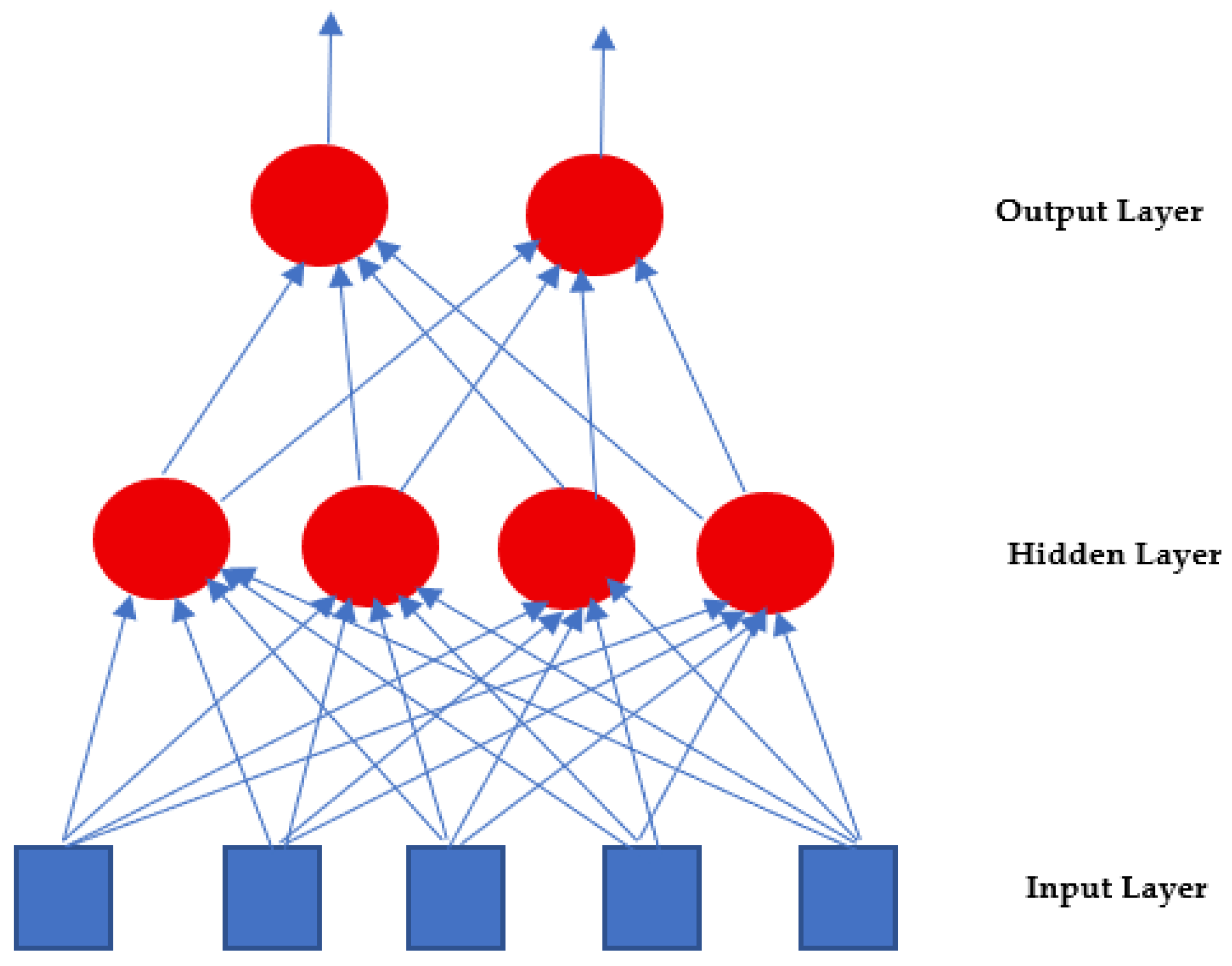
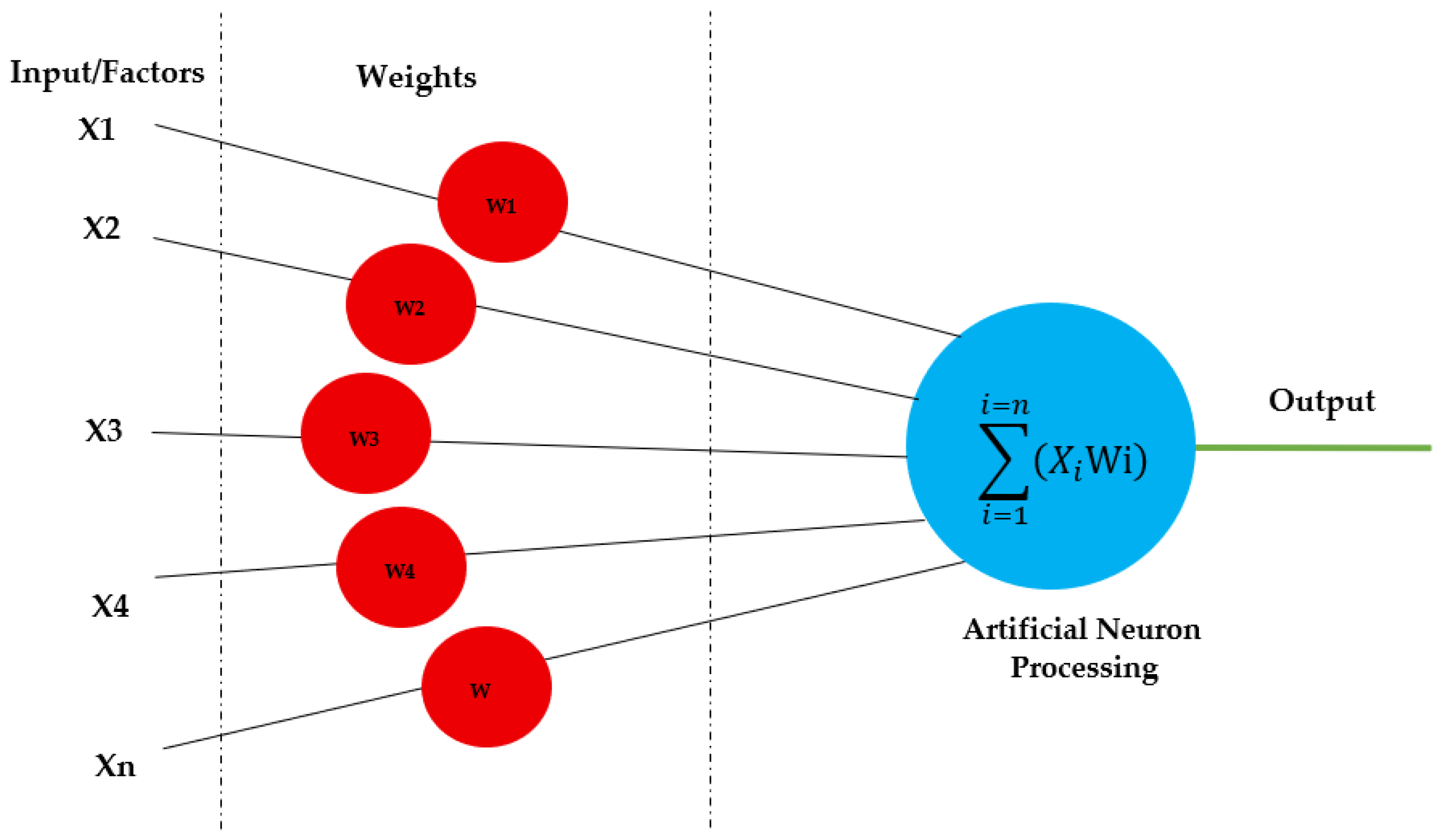
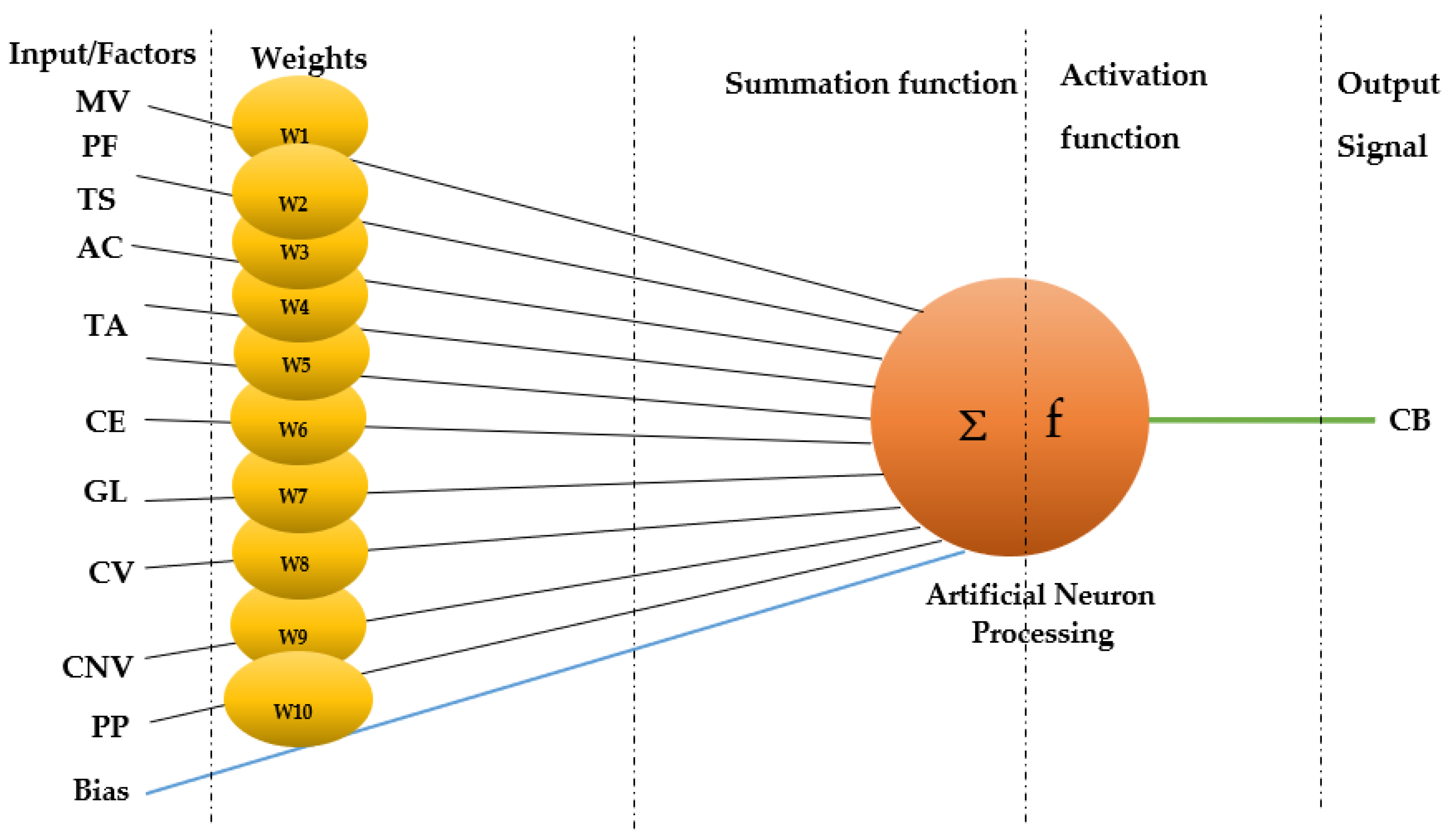
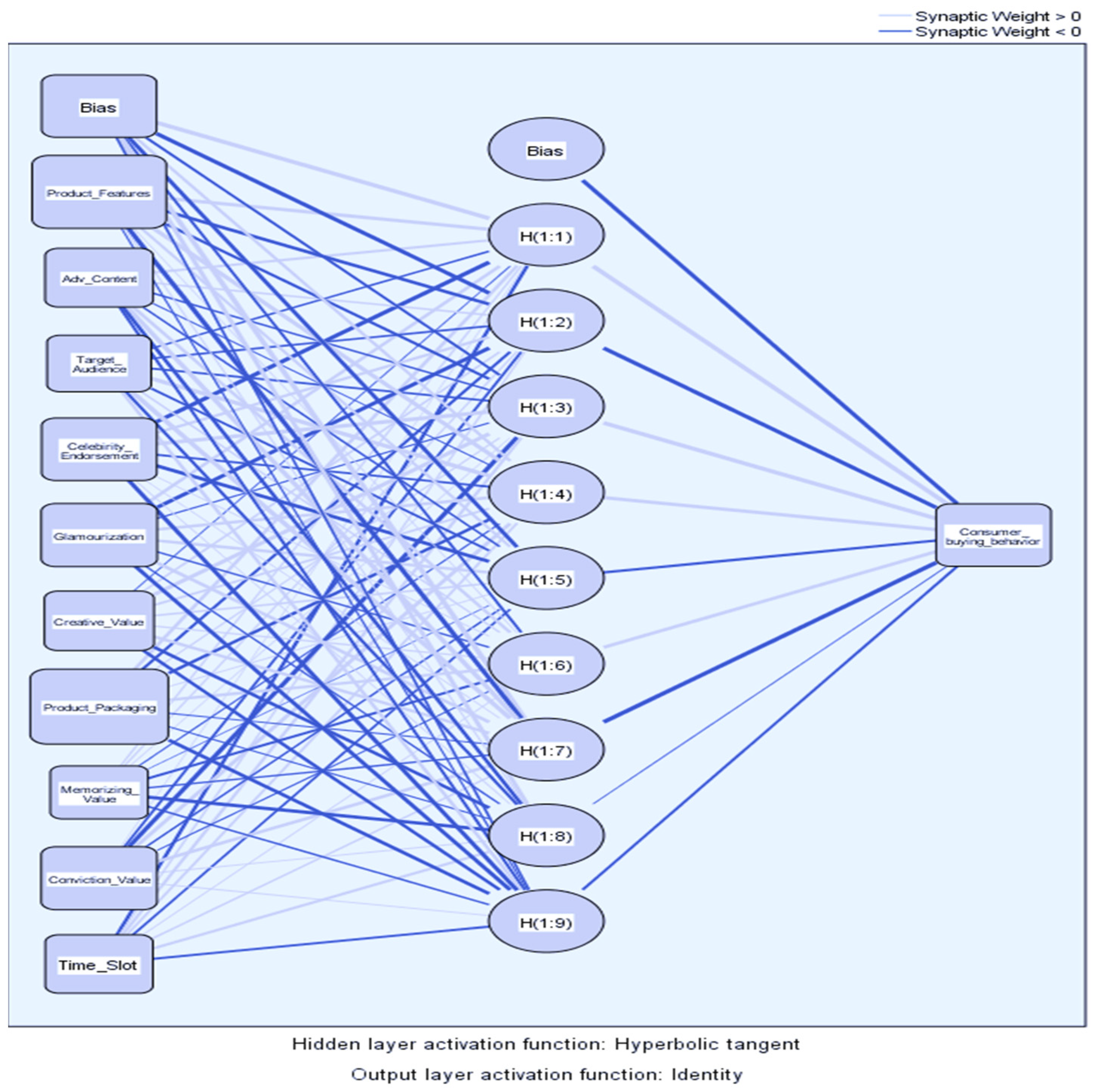
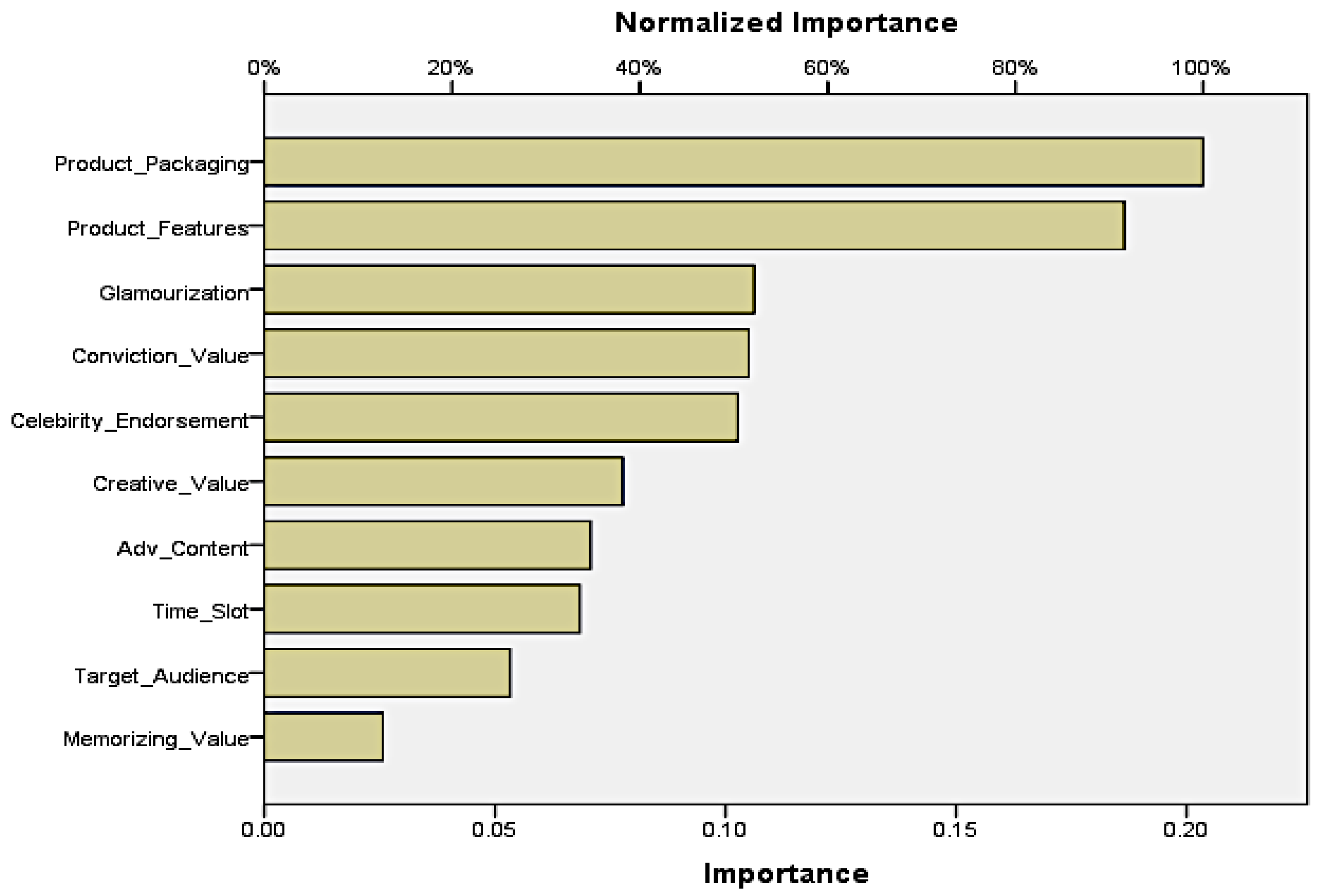
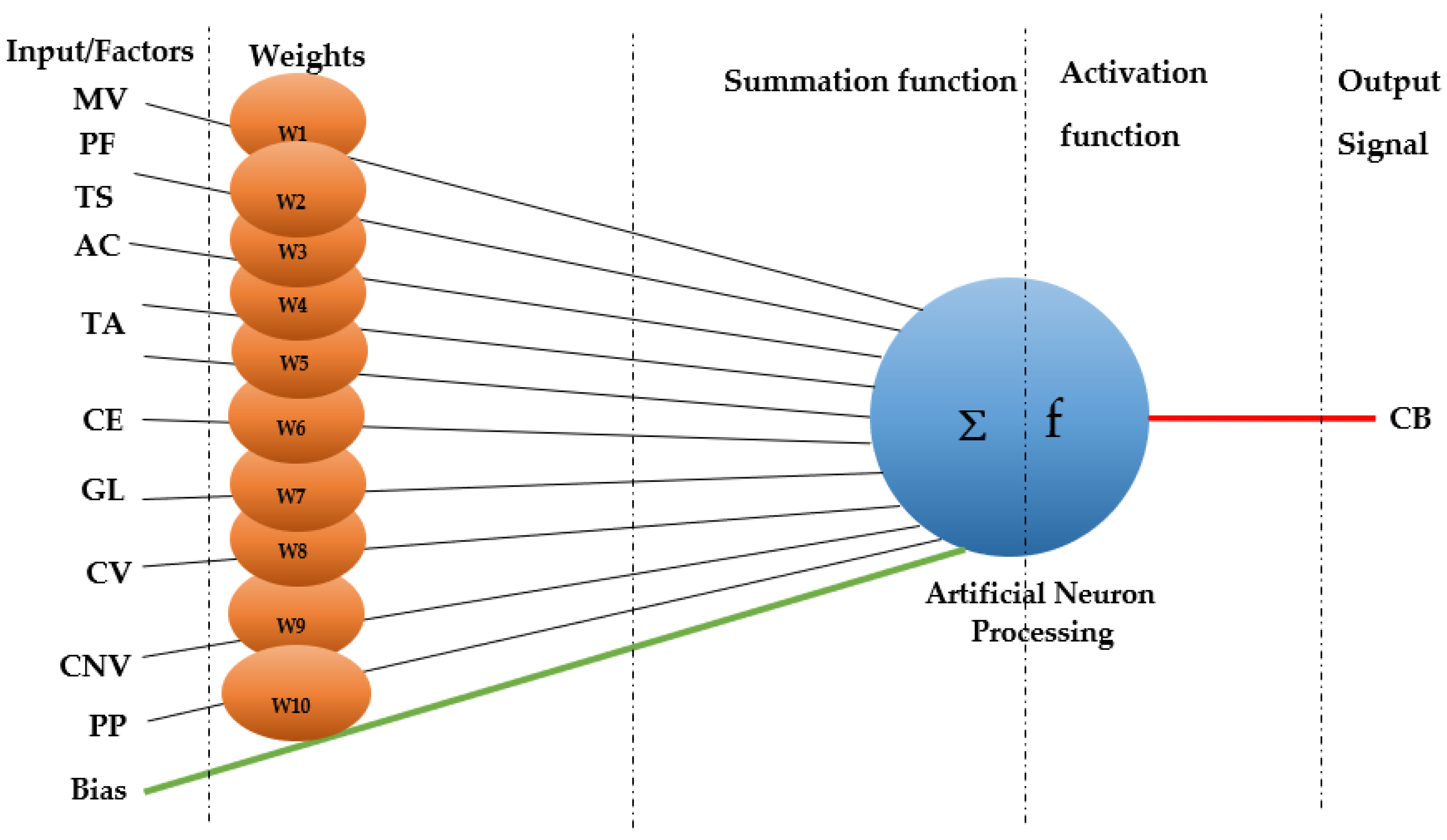
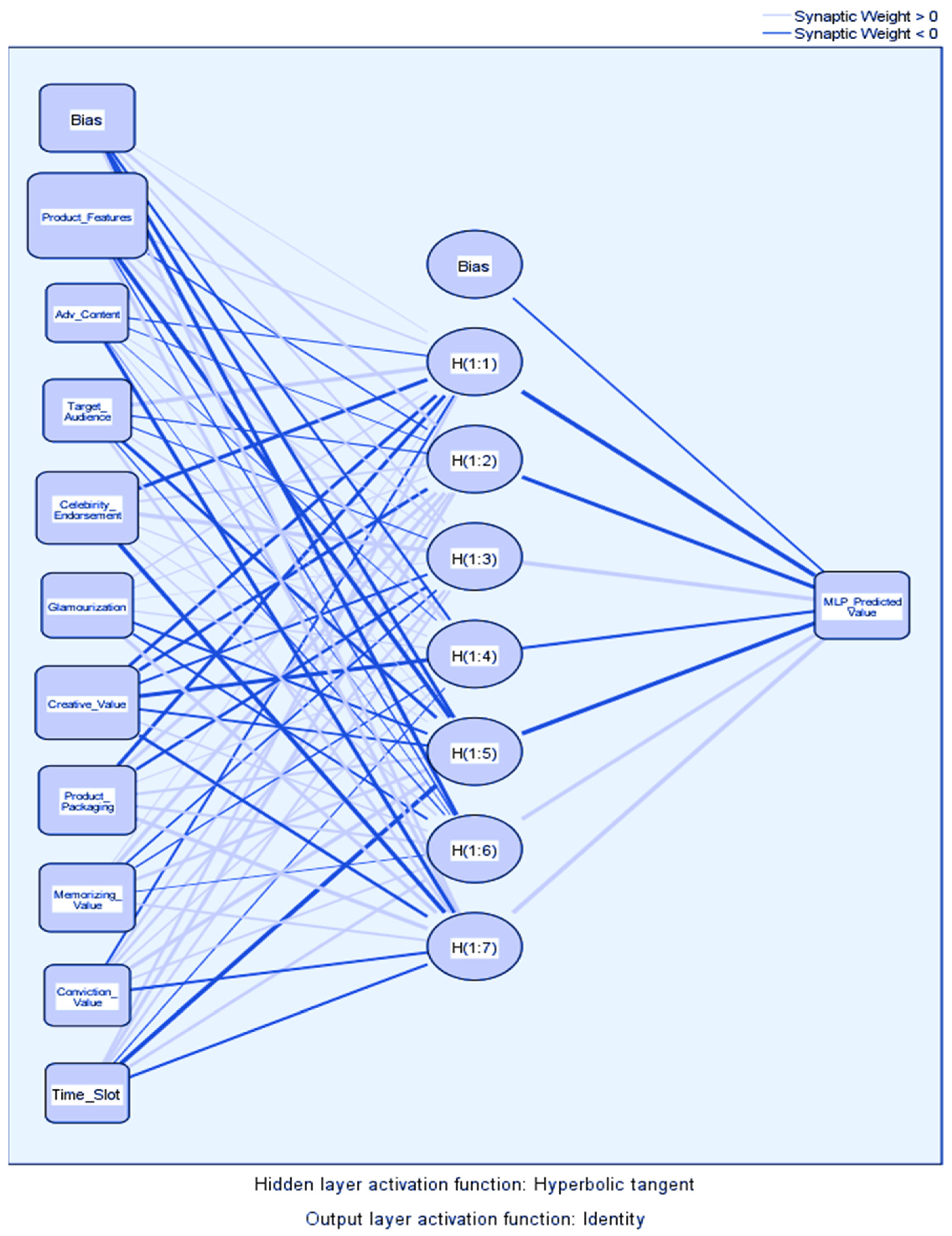
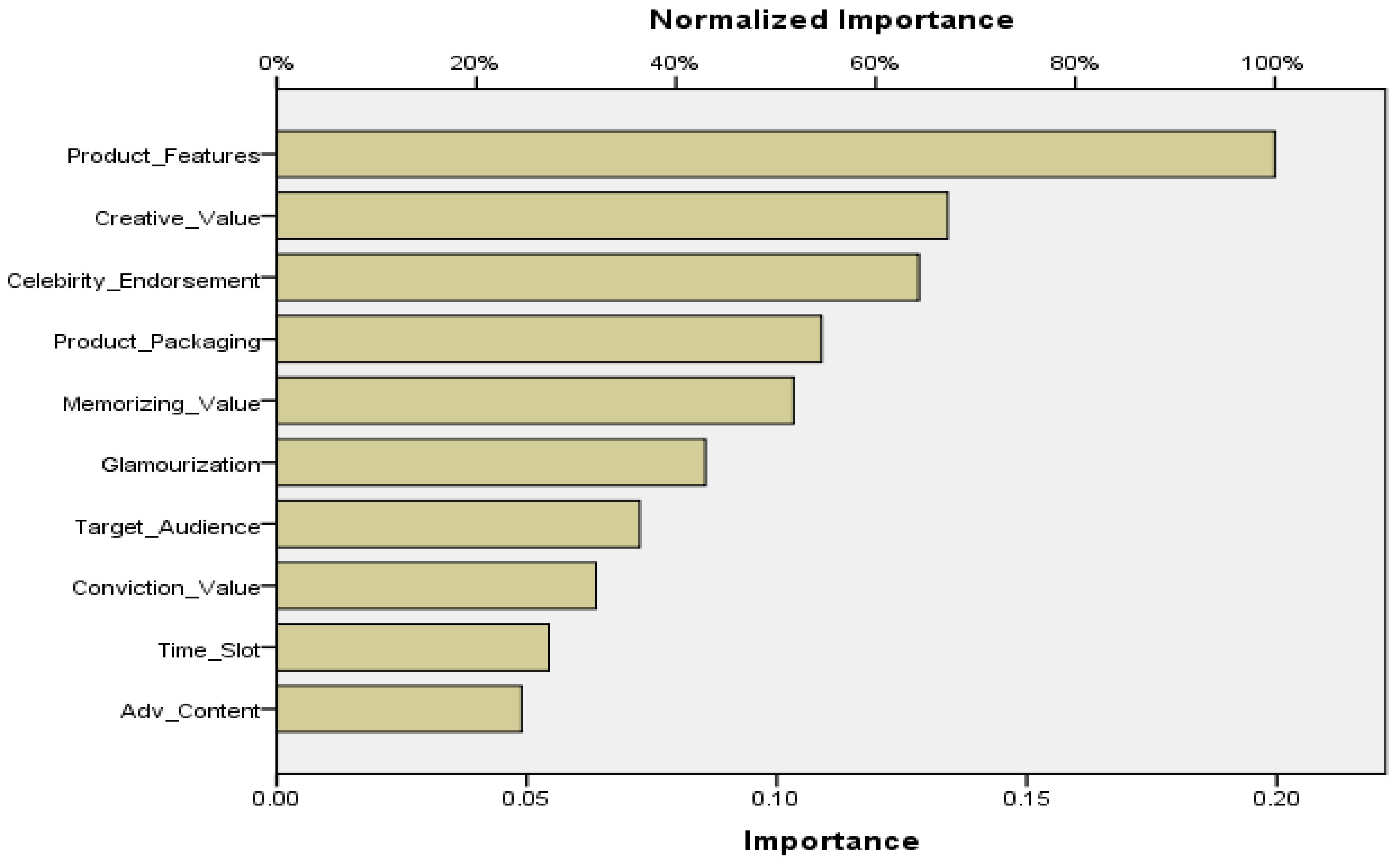
| N | Percent | ||
|---|---|---|---|
| Sample | Training | 414 | 70.8% |
| Testing | 171 | 29.2% | |
| Valid | 585 | 100.0% | |
| Excluded | 0 | ||
| Total | 585 | ||
| Training | Sum of Squares Error | 1.973 |
| Relative Error | 0.010 | |
| Stopping Rule Used | One consecutive step(s) with no decrease in error a | |
| Training Time | 0:00:00.13 | |
| Testing | Sum of Squares Error | 1.539 |
| Relative Error | 0.019 |
| Predictors | Predicted | ||||||||||
|---|---|---|---|---|---|---|---|---|---|---|---|
| Hidden Layer 1 | Output | ||||||||||
| H(1:1) | H(1:2) | H(1:3) | H(1:4) | H(1:5) | H(1:6) | H(1:7) | H(1:8) | H(1:9) | Consumer_Buying_Behavior | ||
| Input Layer | (Bias) | 1.074 | −0.637 | −0.279 | 0.321 | −0.456 | −0.261 | 0.808 | 0.492 | −0.226 | |
| Product_Features | 0.534 | −0.440 | −0.337 | 0.582 | 0.288 | 0.019 | −0.609 | 0.104 | −0.140 | ||
| Adv_Content | 0.315 | 0.207 | −0.192 | −0.094 | −0.197 | 0.358 | 0.705 | −0.409 | −0.287 | ||
| Target_Audience | −0.201 | −0.231 | −0.243 | 0.820 | −0.261 | 0.170 | 0.744 | −0.316 | 0.339 | ||
| Celebirity_Endorsement | −0.731 | 0.364 | 0.743 | −0.246 | −0.528 | 0.031 | 0.028 | 0.034 | −0.494 | ||
| Glamourization | 0.380 | −0.551 | −0.140 | 0.420 | 0.419 | −0.171 | 0.437 | −0.164 | −0.458 | ||
| Creative_Value | −0.054 | 0.203 | 0.576 | 0.257 | 0.229 | 0.155 | 0.412 | −0.434 | −0.397 | ||
| Product_Packaging | 0.369 | −0.294 | 0.138 | −0.383 | 0.091 | 0.386 | −0.115 | −0.129 | −0.450 | ||
| Memorizing_Value | 0.152 | 0.143 | 0.010 | −0.130 | −0.005 | −0.290 | −0.176 | −0.492 | −0.184 | ||
| Conviction_Value | 0.000 | −0.236 | −0.606 | 0.440 | −0.177 | −0.128 | 0.438 | 0.086 | 0.077 | ||
| Time_Slot | −0.348 | 0.164 | 0.311 | 0.234 | −0.229 | 0.056 | 0.188 | 0.324 | −0.267 | ||
| Hidden Layer 1 | (Bias) | −0.551 | |||||||||
| H(1:1) | 0.883 | ||||||||||
| H(1:2) | −0.688 | ||||||||||
| H(1:3) | 0.925 | ||||||||||
| H(1:4) | 0.544 | ||||||||||
| H(1:5) | −0.331 | ||||||||||
| H(1:6) | 0.467 | ||||||||||
| H(1:7) | −0.797 | ||||||||||
| H(1:8) | −0.035 | ||||||||||
| H(1:9) | −0.273 | ||||||||||
| Predictors | Importance | Normalized Importance |
|---|---|---|
| Product Features | 0.187 | 91.6% |
| Advertisement Content | 0.071 | 34.8% |
| Target Audience | 0.053 | 26.2% |
| Celebrity Endorsement | 0.103 | 50.4% |
| Glamourization | 0.106 | 52.2% |
| Creative Value | 0.078 | 38.2% |
| Product Packaging | 0.204 | 100.0% |
| Memorizing Value | 0.026 | 12.6% |
| Conviction Value | 0.105 | 51.6% |
| Time Slot | 0.068 | 33.6% |
| Training | Sum of Squares Error | 0.871 |
| Relative Error | 0.004 | |
| Stopping Rule Used | One consecutive step(s) with no decrease in error a | |
| Training Time | 0:00:00.10 | |
| Testing | Sum of Squares Error | 0.926 |
| Relative Error | 0.010 |
| Predictors | Predicted | ||||||||
|---|---|---|---|---|---|---|---|---|---|
| Hidden Layer 1 | Output Layer | ||||||||
| H(1:1) | H(1:2) | H(1:3) | H(1:4) | H(1:5) | H(1:6) | H(1:7) | MLP Predicted Value | ||
| Input Layer | (Bias) | 0.019 | 0.423 | 0.243 | −0.325 | −0.440 | −0.607 | 0.371 | |
| Product_Features | 0.173 | −0.136 | 0.252 | 0.430 | −0.804 | −0.122 | 0.529 | ||
| Adv_Content | −0.096 | −0.056 | 0.060 | −0.041 | 0.025 | −0.015 | −0.531 | ||
| Target_Audience | 0.808 | −0.117 | −0.069 | 0.189 | −0.428 | −0.095 | 0.356 | ||
| Celebirity_Endorsement | −0.566 | 0.229 | 1.028 | 0.094 | 0.051 | 0.162 | −0.776 | ||
| Glamourization | 0.147 | 0.069 | 0.009 | 0.130 | −0.332 | −0.262 | 0.545 | ||
| Creative_Value | −0.463 | −0.443 | −0.326 | −0.737 | −0.296 | 0.212 | −0.418 | ||
| Product_Packaging | −0.526 | 0.521 | −0.367 | 0.067 | 0.353 | 0.356 | 0.689 | ||
| Memorizing_Value | 0.059 | 0.618 | −0.212 | −0.123 | 0.431 | −0.050 | 0.321 | ||
| Conviction_Value | −0.260 | 0.338 | 0.356 | 0.140 | 0.667 | 0.232 | −0.339 | ||
| Time_Slot | 0.361 | 0.548 | 0.276 | −0.075 | −0.831 | 0.392 | −0.350 | ||
| Hidden Layer 1 | (Bias) | −0.227 | |||||||
| H(1:1) | −0.948 | ||||||||
| H(1:2) | −0.614 | ||||||||
| H(1:3) | 0.819 | ||||||||
| H(1:4) | −0.364 | ||||||||
| H(1:5) | −0.811 | ||||||||
| H(1:6) | 0.638 | ||||||||
| H(1:7) | 0.933 | ||||||||
| Predictors | Importance | Normalized Importance |
|---|---|---|
| Product Features | 0.200 | 100.0% |
| Advertisement Content | 0.049 | 24.5% |
| Target Audience | 0.073 | 36.3% |
| Celebrity Endorsement | 0.128 | 64.3% |
| Glamourization | 0.086 | 42.9% |
| Creative Value | 0.134 | 67.2% |
| Product Packaging | 0.109 | 54.6% |
| Memorizing Value | 0.103 | 51.8% |
| Conviction Value | 0.064 | 32.0% |
| Time_Slot | 0.054 | 27.2% |
Publisher’s Note: MDPI stays neutral with regard to jurisdictional claims in published maps and institutional affiliations. |
© 2022 by the authors. Licensee MDPI, Basel, Switzerland. This article is an open access article distributed under the terms and conditions of the Creative Commons Attribution (CC BY) license (https://creativecommons.org/licenses/by/4.0/).
Share and Cite
Ahmed, R.R.; Streimikiene, D.; Channar, Z.A.; Soomro, H.A.; Streimikis, J.; Kyriakopoulos, G.L. The Neuromarketing Concept in Artificial Neural Networks: A Case of Forecasting and Simulation from the Advertising Industry. Sustainability 2022, 14, 8546. https://doi.org/10.3390/su14148546
Ahmed RR, Streimikiene D, Channar ZA, Soomro HA, Streimikis J, Kyriakopoulos GL. The Neuromarketing Concept in Artificial Neural Networks: A Case of Forecasting and Simulation from the Advertising Industry. Sustainability. 2022; 14(14):8546. https://doi.org/10.3390/su14148546
Chicago/Turabian StyleAhmed, Rizwan Raheem, Dalia Streimikiene, Zahid Ali Channar, Hassan Abbas Soomro, Justas Streimikis, and Grigorios L. Kyriakopoulos. 2022. "The Neuromarketing Concept in Artificial Neural Networks: A Case of Forecasting and Simulation from the Advertising Industry" Sustainability 14, no. 14: 8546. https://doi.org/10.3390/su14148546
APA StyleAhmed, R. R., Streimikiene, D., Channar, Z. A., Soomro, H. A., Streimikis, J., & Kyriakopoulos, G. L. (2022). The Neuromarketing Concept in Artificial Neural Networks: A Case of Forecasting and Simulation from the Advertising Industry. Sustainability, 14(14), 8546. https://doi.org/10.3390/su14148546










